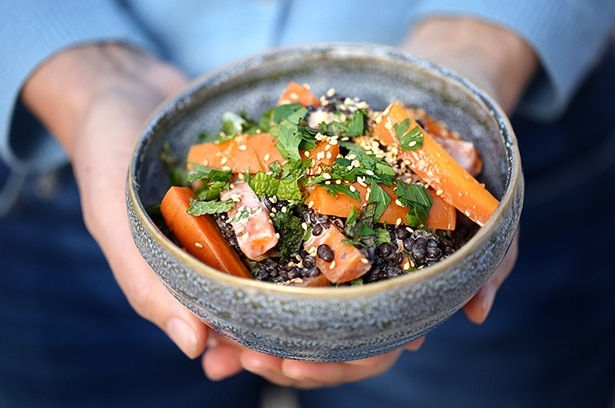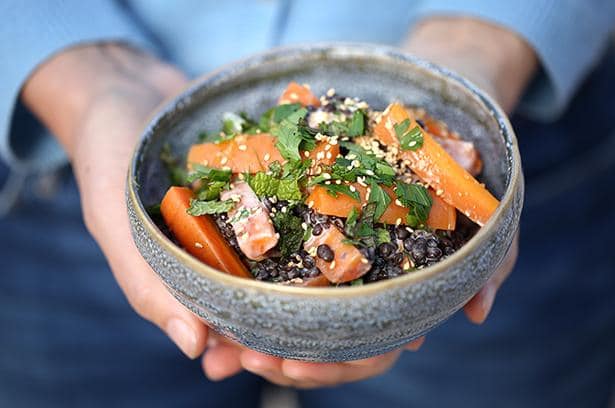Warm Belugal Lentil Salad
My recipe against stress

There are those days when everything grows over my head. I’m a rather enthusiastic person by nature and love to do different things, like writing books, tackling large projects, developing new recipes, revising my website, helping others with their work – and of course, preferably all at the same time. At some point the moment of overload comes. I can already tell from the fact that my sleep is getting worse because my thoughts are circling. Then suddenly I don’t feel like cooking anymore, at least not for “normal food” outside of the recipe development. Then I know that it’s time to rest and reorient myself. I’ve found that three things help me in these moments:
- a new perspective
- proper nutrition
- movement
A new perspective
Overwork and stress arise in the head. Namely by trying to completely oversee and control our present and future life in the present moment. However, it is impossible to keep things under control that haven’t even happened yet (and maybe never will). If we try anyway, fears and worries arise and we imagine “worst case scenarios”. When I find myself in this uncomfortable situation, it helps me to remember that I am trying to accomplish an impossible task. Instead of continuing to reel off the mantra “I’m going crazy” in my head, my new mantras are then: “I take one step at a time”. “When the moment comes, I’ll find a good solution”. “I have already achieved so much, I will do this too”. Life is what happens while we make other plans. So it makes more sense to approach life in small steps and solve one task at a time. Then we come to the point where we look at what we’ve done and see that it’s a lot – and it wasn’t even as strenuous as we thought before.
Proper nutrition
Another cure for stress is our food. When we are stressed or fearful, we unconsciously reach for foods that seem to help us in the short term, but in truth only stimulate the roller coaster of emotions: Sugar and coffee. When we experience stress, our adrenal glands (located at the top of our kidneys) release the hormones adrenaline and noradrenaline. These widen our blood vessels in our muscles, legs, arms, and heart so that we have enough energy to fight or flee. About a quarter of an hour later, the adrenal glands release the hormone cortisol, which mobilizes all of our energy reserves and increases our alertness, so that we can survive the crisis situation well. However, if we often have (internal) stress, the adrenal glands can become exhausted, so that they no longer produce sufficient cortisol. Then one speaks of adrenal fatigue, which manifests itself in exhaustion and chronic fatigue. However, cortisol is also responsible for healthy blood sugar levels. Because of this, we feel hypoglycemic and hungry when our body is not making enough cortisol. However, we can literally eat our adrenal glands healthy, and thus also lower our stress levels, if we observe the following:
-
- Eat fiber-rich food. Above all, the fiber in vegetables, legumes, pseudo-grains, nuts, seeds and small amounts of fruit keep our blood sugar in balance.
- Use healthy salt. Natural salt such as Himalayan, crystal or rock salt helps with the regeneration of the adrenal glands, since exhausted adrenal glands also produce too little of the hormone aldosterone, which regulates the body’s water and salt balance. For this reason, exhaustion of the adrenal glands can lead to a loss of healthy salts in the body. So don’t be afraid of healthy salt! It is not for nothing that brine is a remedy and sodium chloride solutions are administered by infusion in hospitals.
- eat regularly and choose foods that are rich in vital nutrients. Your body gets stressed when you eat too irregularly or too little for your energy needs. Also make sure that your food contains as many vital nutrients as possible. They are the silent helpers who support your organism in all its tasks and help it to regenerate.
- Consume as little stimulating drinks and food as possible. Since caffeine stimulates the stress hormones, we should only consume it in small amounts or – if the adrenal glands are already exhausted – not at all for a while. Instead, drink LOTS of water, because even a slight loss of fluid of just 3% affects our mental performance and makes us more susceptible to factors that trigger stress.
Movement
Exercise is the best remedy for stress, as you’ve probably heard already many times. While we are moving, our body can break down the stress hormones that have arisen. If we exercise in nature instead of in the gym, the green of the plants and the fresh air also have a positive impact on our nervous system. By the way, you don’t even have to try hard to get a good result. Walking briskly for half an hour clears your head and helps you to put things back into perspective.
But what does all of this have to do with this recipe?
Our body is smart when we allow it to be. Yesterday, when I was feeling stressed about too much planning and projects, mine suddenly felt like eating beluga lentils and carrots. Indeed, this combination could be called the perfect “anti-stress recipe”. The fiber in beluga lentils keeps blood sugar in balance, while its B vitamins soothe our battered nerves. Carrots have a relaxing effect on the body and reduce nervousness and anxiety. For this reason, they are also recommended for depression or for convalescence after an illness or an operation. The sesame in this recipe is a fortifying food that increases physical energy in all types of weakness. Incidentally, the ancient Greeks already knew this, and when they went to war they always had a packet of sesame with them to keep them refreshed. So the next time you feel stressed out, take a little walk, put things into the right perspective, and then cook yourself a delicious anti-stress meal that will quietly help you keep your nerves while you just enjoy your food.
And now my question for you: what are your tips and tricks against stress? What works and what doesn’t? Let me know and leave a comment below!




WARM BELUGA LENTILS SALAD
Ingredients
- 200 g beluga lentils
- 400 ml water
- 1/2 tsp salt
- 550 g carrots
- 1 tbsp sesame seeds
- 5 tbsp chopped flat-leaf parsley
- 4 tbsp chopped mint
For the dressing:
- 50 ml freshly squeezed lemon juice
- 3 tbsp olive oil
- 2 tbsp tahini toasted sesame seeds paste
- 1 tbsp maple syrup
- 2/3 tsp salt
- 1/3 tsp cumin ground
- 100 ml hot water
Equipment
- blender
Instructions
- Put the beluga lentils in a sieve and wash. Then bring them to boil with the water in a saucepan. Reduce the heat and let it simmer with closed lid for about 30 minutes until the lentils are firm to the bite. Only at the end of the cooking time add the salt. Drain into a sieve, return to the saucepan and keep warm.
- While the lentils are cooking, prepare the carrots: wash the carrots thoroughly and trim the ends. Cut in half lengthways. Then cut each half into thirds lengthways, then cut into approx. 6 cm long sticks. Bring a saucepan of water to the boil, season with salt and simmer the carrot sticks for about 6 minutes. Drain, return to the saucepan and keep warm.
- Mix freshly squeezed lemon juice, olive oil, tahini, maple syrup, salt, cumin and hot water in a blender until creamy. That's the salad dressing.
- Heat a small pan and stir-fry the sesame seeds for approx. 2 minutes without fat, until they start to smell.
- Mix the beluga lentils, carrots and dressing in a bowl. Add 2/3 of the herbs and fold in. Arrange the salad on plates, sprinkle with the remaining herbs and roasted sesame seeds and serve.
